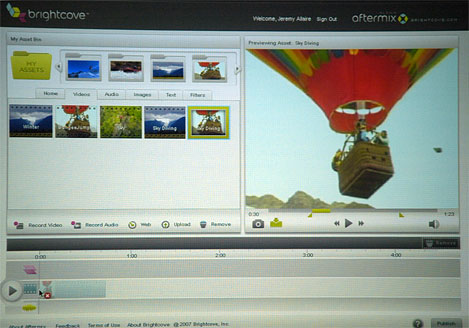GooTube lookout: Jeremy Allaire debuts "Aftermix" as part of a re-tooled Brightcove

Shortly after Adobe's senior vice president and chief architect Kevin Lynch gave an overview of the company's roadmap for its Apollo platform here at the company's Engage event, developers who are working with the platform took turns at the podium to demonstrate what they've done. So far, the most impressive has been Aftermix from BrightCove, shown by Brightcove founder and CEO Jeremy Allaire. Allaire also has the title of Founder Emeritus of Macromedia which was acquired by Adobe for $3.4 billion in the Spring of 2005.
During his presentation, Allaire talked about how the Brightcove Web site is being re-tooled to have much more of a consumer focus as opposed to being directed at professional producers of video such as media companies. That said, that doesn't mean the company won't continue to engage the professoinal video community. In fact, one of the most interesting features of Aftermix is how it allows consumers to borrow footage from professionally produced video for incorporation into their own work (so long as the original publisher of the content has a license that allows for that).
But what really sets Aftermix apart from other social video sites are two features. First, the ability to record video directly to the Web. Second, none of the tools to create or edit the videos come from locally loaded software. In terms of recording directly to the Web, Alliare showed how with a very basic Web cam, he can record a video clip that can immediately be uploaded to Brightcove's servers where it becomes instantly available for inclusion in whatever video you're editing (I can see this coming in really handy for doing quick voice overs).
So, imagine for example, YouTube, but with all the video editing tools built right into the Web site in a way that users didn't need a video-making program like iMovie, Final Cut, or Premier, or MovieMaker. The entire solution, built on top of Adobe's Flash offers all sorts of video editing capability that you'd normally associate with locally loaded software and was suprisingly snappy in the demonstration given by Allaire. For example, any clip that's being pulled into a project can be trimmed (so that you don't have to take the entire clip). Sound tracks and voice overs can be dropped in (MP3's are supported for example) and the interface handles transitions between scenes.
Allaire couldn't furnish me with any screen shots as the product hasn't been demonstrated publicly yet and there's no official press kit with stock images that's available to bloggers or members of the press, but I was able to snag and edit-for-better-viewability a photo of Aftermix's user interface in action.

Although Allaire referred them as bins of content, you essentially have folder-type access to categories of content. Some folders may be your own content (see, My Assets, upper left hand corner) while other folders (eg: the right most one which contains ballooning videos) may contain videos that were contributed by others that users can remix into their own videos (as is being shown in the UI, where a ballooning video has been pulled into the project and is the clip that's currently being edited). Media clips (video and audio) and images can easily be dragged and dropped onto the timeline at the bottom where all the media is assembled into a final project. Although it's hard to see in this image, just above the timeline on the left side are buttons for recording video (if you have a camera attached to the PC), recording audio, uploading, or downloading video.
One of the main advantages of building tools like this on top of Flash is how much easier it is to make the tools available to users of different platforms (since Flash works across platforms).